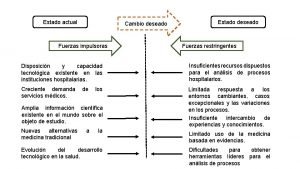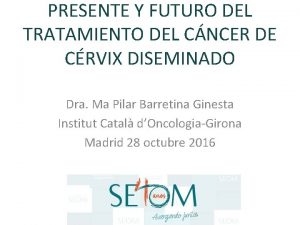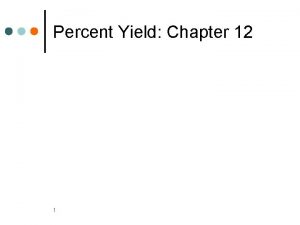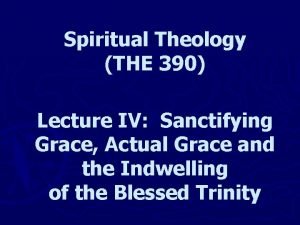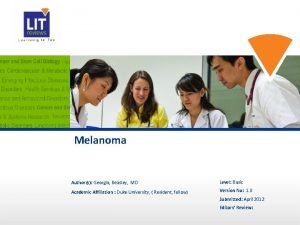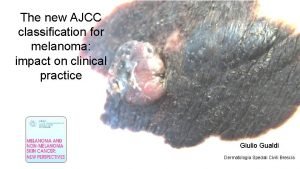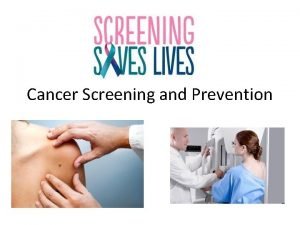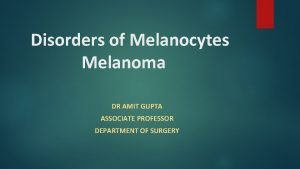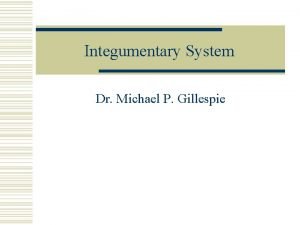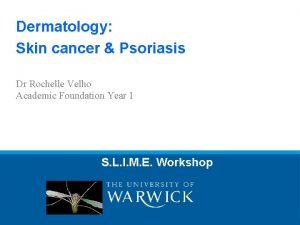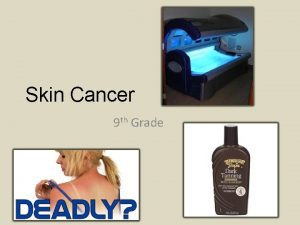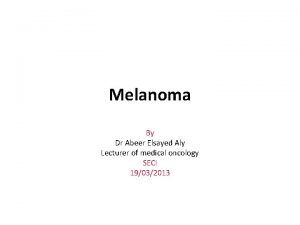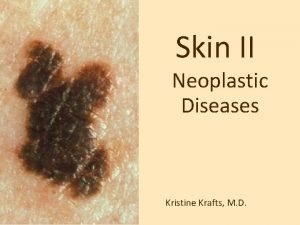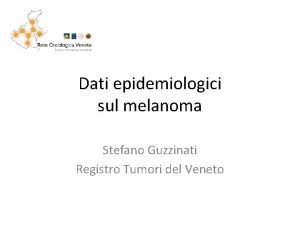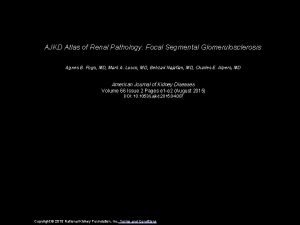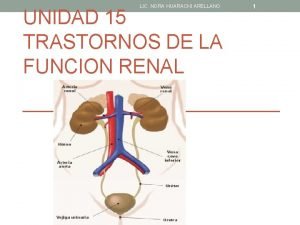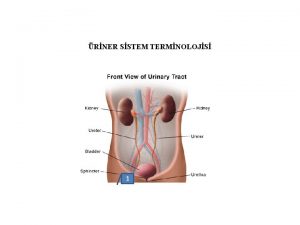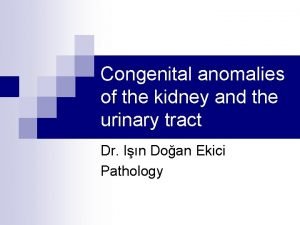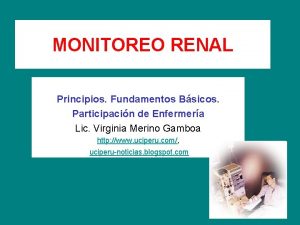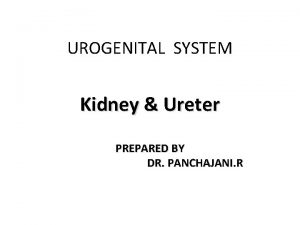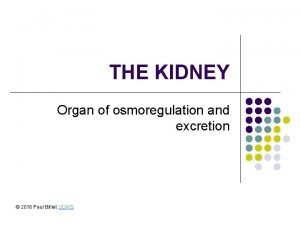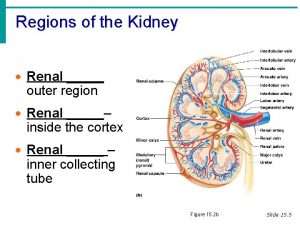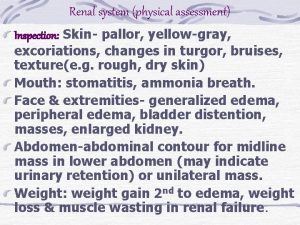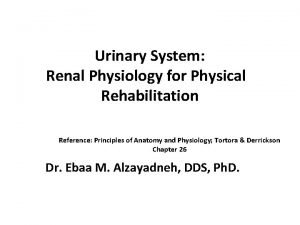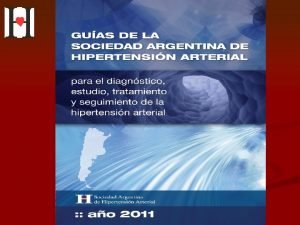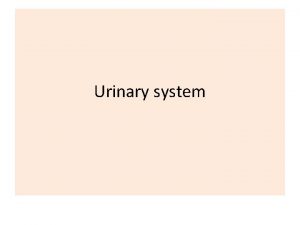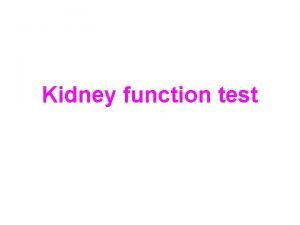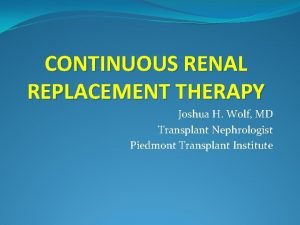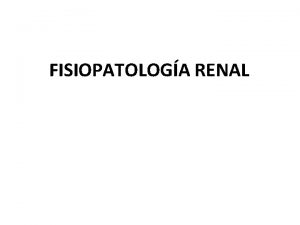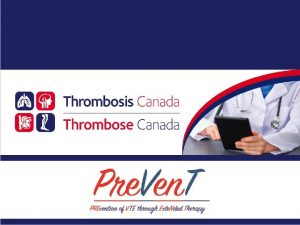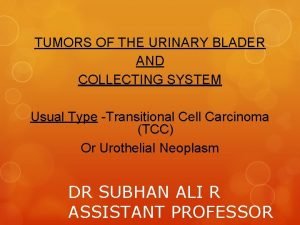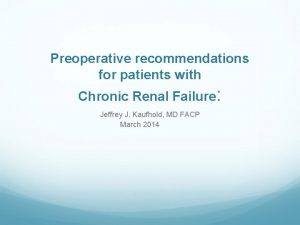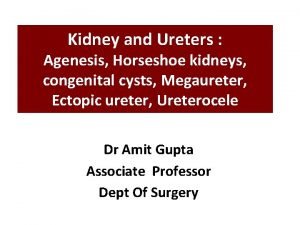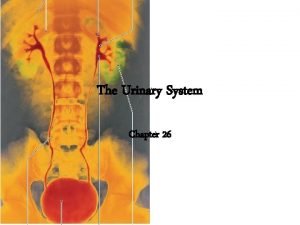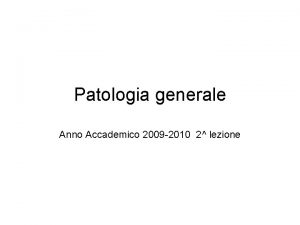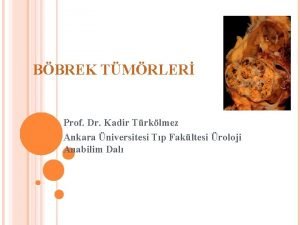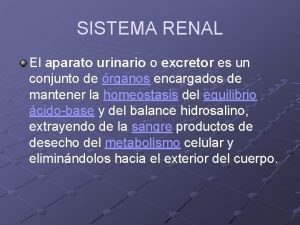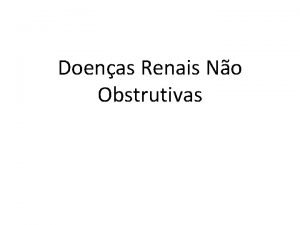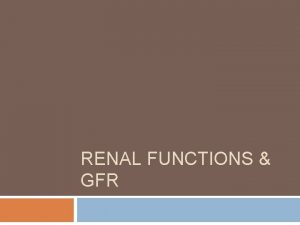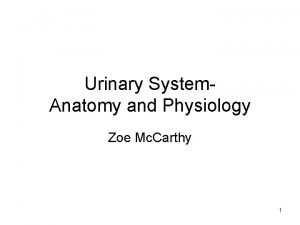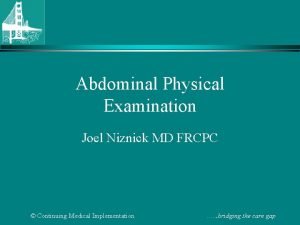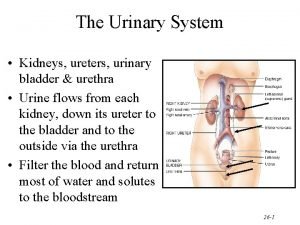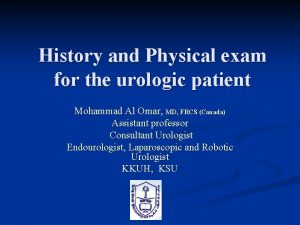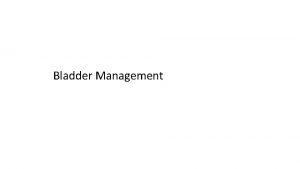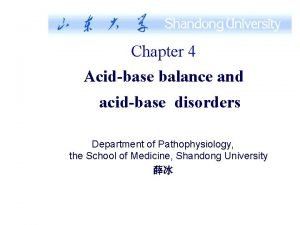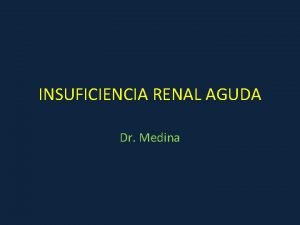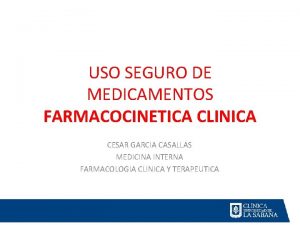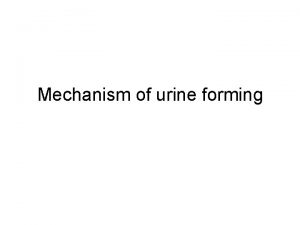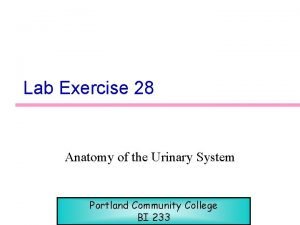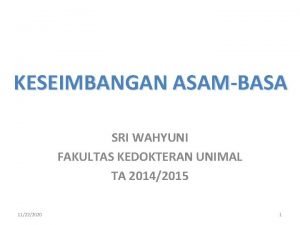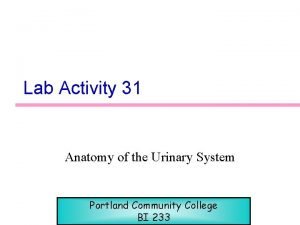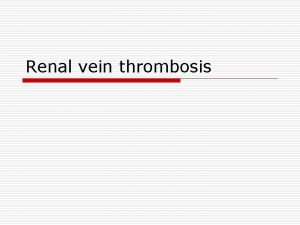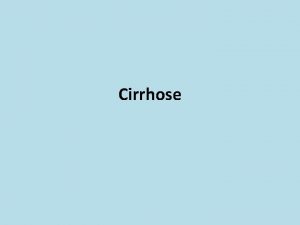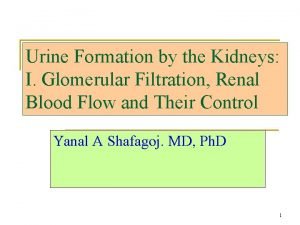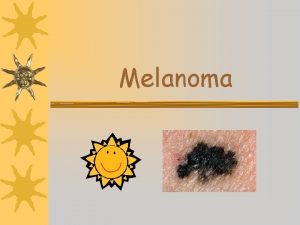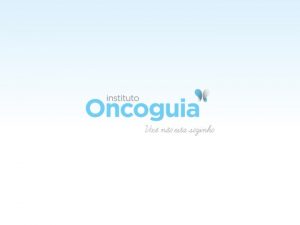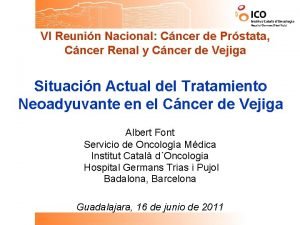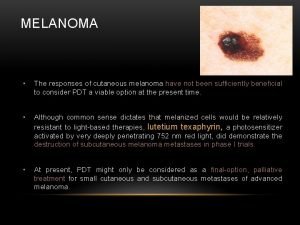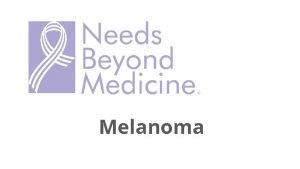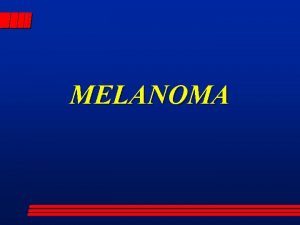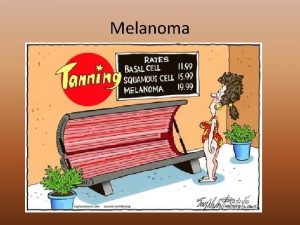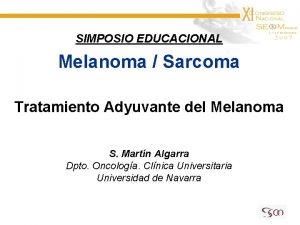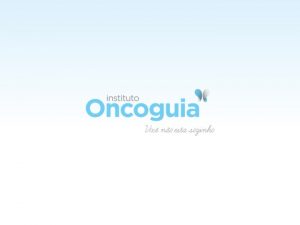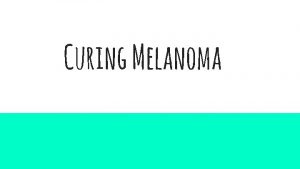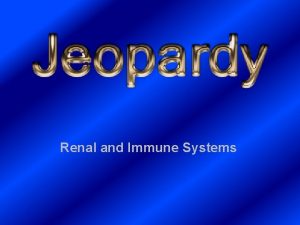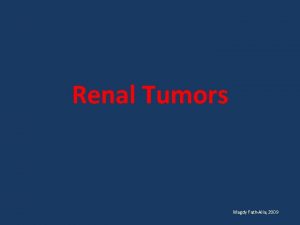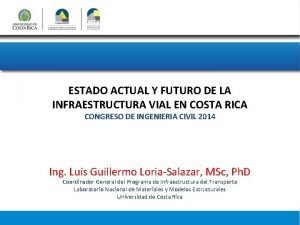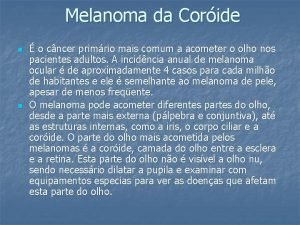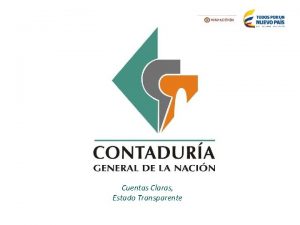INMUNOONCOLOGIA Estado actual y futuro Cncer Renal Melanoma








































































- Slides: 72

INMUNO-ONCOLOGIA Estado actual y futuro Cáncer Renal, Melanoma, Cáncer de Pulmón y Medicina de Precisión Dr. Carlos Silva Hospital Británico de Buenos Aires-Hospital Universitario Austral Universidad Católica Argentina

Declaración de Intereses • Doy o he dado conferencias convocado por: Astra Zéneca, Bristol Myers, MSD, Pfizer, Roche. • Pertenezco o he pertenecido a Advisory Boards de Astra Zéneca, Bristol Myers, MSD, Pfizer, Roche. • He percibido honorarios por estas actividades. • No he sido ni soy medical advisor de ningún laboratorio. • He asesorado al Ministerio de Salud de la República Argentina. • He sido auditor de uno de los tres sistemas privados de salud más grandes de Argentina (SPM-Galeno).

Agenda • Bases biológicas de la Inmuno Oncología • Impacto de la Inmuno Oncología en el tratamiento del cáncer • Tratamiento del Cáncer Renal avanzado primera línea • Tratamiento del Melanoma en Adyuvancia y enfermedad avanzada • Tratamiento del Cáncer de Pulmón en segunda línea • Biomarcadores • Futuro no tan futuro

Agenda • Bases biológicas de la Inmuno Oncología • Impacto de la Inmuno Oncología en el tratamiento del cáncer • Tratamiento del Cáncer Renal avanzado primera línea • Tratamiento del Melanoma en Adyuvancia y enfermedad avanzada • Tratamiento del Cáncer de Pulmón en segunda línea • Biomarcadores • Futuro no tan futuro

Hoy encontramos 10 hitos fundamentales relacionados con la formación del cáncer Inhibidores vía EGFR Señal proliferativa sostenida Inhibidores glicólisis aerobia Inhibidores quinasas dependiente ciclinas Evadiendo señales supresoras Metabolismo celular desregulado Pro-apoptóticos BH 3 miméticos Evadiendo inmunidad Resistencia muerte celular Pemitiendo Inmortalidad replicativa Inhibidores telomerasa Inflamación promovida por tumor Inestabilidad y mutación genómica Inhibidores PARP Activación Inmune Anti CTLA 4 Inducción angiogénesis Inhibidores vía VEGF Activación Invasión y metástasis Drogas antiinflamat selectivas Inhibidores HGF/c-Met Hanahan & Weinberg. Cell 2011

¿QUE • La. ES INMUNO-ONCOLOGĺA? Inmuno-Oncología comprende el desarrollo y utilización de nuevos componentes • • que aprovechan el sistema inmune del propio paciente para combatir el cáncer • Impulsan las propiedades únicas del sistema inmune (especificidad, memoria, adaptabilidad, efectos sistémicos) • Distintos de la cirugía, radioterapia, y modalidades citotóxicas/modalidades blanco que impactan al tumor Se ha identificado un número blancos terapéuticos basado en nuestra mejor comprensión del sistema inmune en el cáncer y los mecanismos que el tumor utiliza para evadirlo El objetivo es volcar el balance en favor de la inmunidad, llevando a la erradicación del tumor o la supresión por largo tiempo del crecimiento tumoral Tiene el potencial de proveer sobrevida durable y a largo témino con una buena calidad de vida para los pacientes con varios tumores sólidos y hematológicos Tiene el potencial de volverse una modalidad nueva e innovadora y los cimientos sobre los cuales construir nuevas estrategias de tratamiento Finn OJ. Ann Oncol. 2012; 23(suppl 8): viii 6–viii 9; De Vita VT, et al. N Engl J Med. 2012; 366: 2207– 2214; Eggermont A. Ann Oncol. 2012; 23 Suppl 8: viii 53–viii 57. 6

Somatic Mutations May Give Rise to Patient-Specific Tumor Neoantigens Presented By Leisha Emens at 2015 ASCO Annual Meeting

ACTIVACIÓN DE LINFOCITOS T CITOTÓXICOS MODELO DE LAS TRES SEÑALES


Agenda • Bases biológicas de la Inmuno Oncología • Impacto de la Inmuno Oncología en el tratamiento del cáncer • Tratamiento del Cáncer Renal avanzado primera línea • Tratamiento del Melanoma en Adyuvancia y enfermedad avanzada • Tratamiento del Cáncer de Pulmón en segunda línea • Biomarcadores • Futuro no tan futuro

MDX 010 -20: 1 - and 2 -Year Survival Rates, OS 1 Survival Rate Median OS, mo 1 Year 2 Year (95%CI) 1. 0 Ipi + gp 100 0. 8 Ipi + pbo 46% gp 100 + pbo 0. 6 Proportion alive 44% 22% 10. 0 (8. 5, 11. 5) 24% 10. 1 (8. 0, 13. 8) 25% 14% 6. 4 (5. 5, 8. 7) 0. 4 0. 2 0. 0 0 1 2 3 4 297 106 136 223 79 93 163 56 58 115 38 32 Years Patients at risk Ipi + gp 100 403 Ipi + pbo 137 Gp 100 + pbo 1. Hodi FS, et al. N Engl J Med 2010; 363: 711 -23. 81 30 23 54 24 17 42 18 16 33 13 7 24 13 5 17 8 5 7 5 3 6 2 1 4 1 0 0 0

Ipilimumab: Association of Response With Survival in Melanoma 1. 0 0. 9 Proportion Alive 0. 8 0. 7 0. 6 0. 5 0. 4 0. 3 0. 2 0. 1 0 CR/PR/SD (by WHO criteria) ir. PR/ir. SD (by the ir. RC) PD and unknown response 0 1 2 3 4 5 6 7 8 9 10 1112 1314 1516 1718 19 2021 22232425 26 27 2829 303132 33 34 Mos Wolchok JD, et al. Clin Cancer Res. 2009; 15: 7412 -7420.

Consistent Survival Benefit in Subpopulations 1 Pre-specified Subgroups in MDX 010 -20 Favors: Ipi + gp 100 Ipi gp 100 ALL PATIENTS Gender Male Female Age < 65 years ≥ 65 years Female < 50 years Female ≥ 50 years M-stage at Study Entry M 0, M 1 A, M 1 B M 1 C Baseline LDH ≤ ULN > ULN ≤ 2 x ULN > 2 x ULN Prior Use of IL-2 Yes No 0. 2 1. Hodi FS, et al. N Engl J Med 2010; 363: 711 -23. 0. 5 1 2 5 0. 2 0. 5 Hazard Ratio and 95% CI 1 2 5

Ipilimumab: Pooled Survival Analysis from Phase II/III Trials in Advanced Melanoma 1. 0 0. 9 N = 1861 Median OS (95% CI): 11. 4 mo (10. 7 -12. 1) 3 -year OS Rate (95% CI): 22% (20% to 24%) Proportion Alive 0. 8 0. 7 0. 6 0. 5 0. 4 0. 3 0. 2 0. 1 Ipilimumab CENSORED 0. 0 0 Patients at Risk Ipilimumab 1861 12 24 36 48 60 72 84 96 108 120 26 15 5 0 Months 839 370 254 192 170 Hodi S, et al. 2013 European Cancer Congress. Abstract LBA 24.


Nivolumab: Duration of Response Proportion progression-free 1. 0 Med. , mo. 0. 9 (95%CI) 0. 8 (9. 7 - NE) 0. 7 0. 6 0. 5 NSCLC (n=22) 17. 0 Melanoma (n=33) 24. 0 (17. 0 - NE) Censored RCC (11. 4 - NE) (n=10) 0. 4 0. 3 0. 2 0. 1 0. 0 0 3 6 9 12 15 of 30 response 21 Months 24 since initiation 27 33 No. at Risk NSCLC 22 21 16 14 MEL 2 1 1 0 RCC 33 33 30 27 5 0 0 0 Topalian SL, et al. ASCO 2013. Abstract 3002. 10 10 10 9 18 12 8 5 2 19 15 12 9 5 3 2 2 12. 9

Ways to enhance T cell attack Presented By Michael Postow at 2017 ASCO Annual Meeting

PERSPECTIVAS DE LA INMUNOTERAPIA PARA EL CÁNCER Human tumour Traditional tumour therapy • Surgical debulking • Radiation therapy • Chemotherapy • Anti-angiogenic therapy Novel tumour immunotherapy Targeting regulatory T cells: • Depleting (Denileukin diftitox, CD 25 -specific antibody, cyclophosphamide) • Blocking trafficking (CCL 22 -specific antibody) • Blocking differentiation and signalling (blocking FOXP 3 signal) Targeting suppressive molecules: • Blocking suppressive molecules (B 7 -H 1, B 7 -H 4, IDO, arginase) on APCs • Blocking suppressive molecules (CTLA 4, PD 1) on T cells • Blocking soluble suppressive molecules (TGFβ, IL-10, VEGF, COX 2 Combinatorial therapy Weiping Zou 2006. Nat Rev. Immunol. 6: 295 -307. Conventional immunotherapy • Tumour-associated antigens (tumour peptides) • APC vaccination (dendritic cells) • Adoptive T-cell transfusion (effector T cells) • Cytokine and/or chemokine administration (IL-7, IL-15 and IL-21)

Agenda • Bases biológicas de la Inmuno Oncología • Impacto de la Inmuno Oncología en el tratamiento del cáncer • Tratamiento del Cáncer Renal avanzado primera línea • Tratamiento del Melanoma en Adyuvancia y enfermedad avanzada • Tratamiento del Cáncer de Pulmón en segunda línea • Biomarcadores • Futuro no tan futuro

¿Todos los pacientes deben ser tratados de inicio?

Treatment Patterns: Untreated Patients • In a large prospective cohort of m. RCC patients, median time to treatment initiation was 7. 2 months, and 20% of patients remained untreated at 4 years Initiation of therapy within: N=920 6 months 47% 1 year 57% 2 years 68% 3 years 74% 4 years 80% 5 years 83% Factors predicting later initiation of targeted therapy: • • • History of radiation therapy Older age at time of metastatic disease Presence of brain metastases only Presence of bone metastases Indolent disease High number of metastatic sites . Bains P et al. Poster presentation at ASCO GU 2015. 424.

¿Cuál es la evidencia de la efectividad de la inmunoterapia para frenar la enfermedad?

Long-Term Overall Survival With Nivolumab in Patients With m. RCC 1. 0 0. 9 Median OS, months (95% CI) Overall Survival (Probability) 0. 8 Nivolumab 0. 7 22. 4 (12. 5–NE) 0. 6 0. 5 38% 0. 4 34% 0. 3 0. 2 0. 1 0. 0 0 • 6 12 18 24 30 36 Number of patients at risk Nivolumab 34 28 24 18 14 13 12 42 48 Months 12 11 In Check. Mate 003, minimum follow-up was 50. 5 months . Mc. Dermott DF et al. Oral presentation at ASCO 2016. 4507. 54 60 66 72 78 84 8 6 6 2 1 0

CA 209 -025/Check. Mate 025 Phase III, randomized, open-label trial of nivolumab vs everolimus in subjects with advanced or metastatic clear cell RCC who have received prior antiangiogenic therapy 1 N=822 Key Inclusion Criteria • Advanced/metastatic clear cell RCC • No more than 3 total prior regimens in advanced/metastatic setting • 1 or 2 prior antiangiogenic therapy regimens in advanced/metastatic setting • Karnofsky PS ≥ 70% • No CNS metastases • No prior therapy with m. TOR inhibitor • No autoimmune disease Start Date: September 2012 Estimated Trial Completion Date: September 2016 Estimated Primary Completion Date: May 2015 Status: Ongoing but not recruiting Trial Director: Bristol-Myers Squibb Nivolumab 3 mg/kg IV q 2 w R 1: 1 • • Everolimus 10 mg PO qd Until progression*, unacceptable toxicity, withdrawal of consent, or end of trial Primary Outcome Measure: OS Secondary Outcome Measures: PFS, ORR, duration of objective response, duration of OS by PD-L 1 status, safety, disease-related symptom progression rate * Patients may continue treatment beyond progression (RECIST 1. 1) if investigator-assessed clinical benefit is achieved and treatment is well-tolerated. 2 1. Clinicaltrials. gov. NCT 01668784. https: //clinicaltrials. gov/ct 2/show/NCT 01668784? term=NCT 01668784&rank=1. Accessed on October 2, 2015. 2. CA 209 -025 clinical protocol. August 27, 2014.

OS in Patients With m. RCC Median OS was 25 months and 19. 6 months in the nivolumab and everolimus groups, respectively Median OS, months (95% CI) 1. 0 Overall Survival (Probability) 0. 9 0. 8 Nivolumab 25. 0 (21. 8–NE) Everolimus 19. 6 (17. 6– 23. 1) 0. 7 0. 6 Nivolumab 0. 5 0. 4 Everolimus 0. 3 0. 2 0. 1 0. 0 0 3 # of patients at risk Nivolumab 410 389 Everolimus 411 366 6 9 12 15 18 21 24 27 30 33 139 115 73 61 29 20 3 2 0 0 Months 359 324 Motzer et al. N Engl J Med. 2015; 373(19): 1803 -1813. 337 287 305 265 275 241 213 187

Duration of Response (DOR) in Patients With m. RCC Responders Majority of patients showed a response at first assessment Nivolumab Everolimus On treatment Off treatment First response Ongoing response 0 16 32 Motzer et al. N Engl J Med. 2015; 373(19): 1803 -1813. 48 64 Time (Weeks) 80 96 112 128

Landmark Overall Survival Analysis in Patients Treated and Not Treated Beyond Progression • In a landmark analysis beginning from 4 weeks post-progression, median OS was 20. 4 months (95% CI, 17. 3–NE) in patients treated with nivolumab beyond progression and 11. 4 months (95% CI, 9. 4– 14. 6) in patients not treated beyond progression Median OS, months (95% CI) Overall Survival (Probability) Overall survival with nivolumab Treated beyond progression 28. 1 (23. 2–NE) Not treated beyond progression 15. 0 (12. 1– 18. 2) 1. 0 HR (95% CI), 0. 41 (0. 29– 0. 57) 0. 9 0. 8 0. 7 Treated beyond progression 0. 6 0. 5 0. 4 0. 3 Not treated beyond progression 0. 2 0. 1 0. 0 0 3 6 9 12 15 18 21 24 27 30 33 65 29 30 16 17 3 2 0 0 0 Months Number of patients at risk TBP NTBP 153 145 153 131 146 113 Escudier B et al. Poster presentation at ASCO 2016. 4509. 142 101 132 84 123 69 96 54

¿En primera línea y en combinación es superior que el actual standard de cuidado?


Overall Survival and Progression-free Survival among IMDC Intermediate- and Poor-Risk Patients. RJ Motzer et al. N Engl J Med 2018; 378: 1277 -1290.

¿Qué pasa si combinamos con antiangiogénicos?

¿Cuál es el rol en adyuvancia y neoadyuvancia?

Agenda • Bases biológicas de la Inmuno Oncología • Impacto de la Inmuno Oncología en el tratamiento del cáncer • Tratamiento del Cáncer Renal avanzado primera línea • Tratamiento del Melanoma en Adyuvancia y enfermedad avanzada • Tratamiento del Cáncer de Pulmón en segunda línea • Biomarcadores • Futuro no tan futuro

3 6

3 7

3 8

Decision Point…. Immunotherapy PD-1 alone PD-1/CTLA-4 Combination

Patients Time to Response and Durability of Response in Patients Who Discontinued Due to Adverse Events (Pooled Analysis of Checkmate 067 and 069 On treatment Off treatment First response Ongoing response 0 8 16 24 32 40 48 56 Weeks Minimum 18 -month follow-up, median 21. 3 -month follow-up. Adapted from Schadendorf D et al. J Clin Oncol. 2017; 35: 3807 -3814. 64 72 80 88 96 104 112

Adjuvant Therapy With Nivolumab Versus Ipilimumab After Complete Resection of Stage III/IV Melanoma: Updated Results from a Phase 3 Trial (Check. Mate 238) Jeffrey Weber, 1 Mario Mandala, 2 Michele Del Vecchio, 3 Helen Gogas, 4 Ana M. Arance, 5 C. Lance Cowey, 6 Stéphane Dalle, 7 Michael Schenker, 8 Vanna Chiarion-Sileni, 9 Ivan Marquez-Rodas, 10 Jean-Jacques Grob, 11 Marcus Butler, 12 Mark R. Middleton, 13 Michele Maio, 14 Victoria Atkinson, 15 Reinhard Dummer, 16 Veerle de Pril, 17 Anila Qureshi, 17 Abdel Saci, 17 James Larkin, 18* Paolo A. Ascierto 19* 1 NYU Perlmutter Cancer Center, New York, USA; 2 Papa Giovanni XIII Hospital, Bergamo, Italy; 3 Medical Oncology, National Cancer Institute, Milan, Italy; 4 University of Athens, Greece; 5 Hospital Clínic de Barcelona, Spain; 6 Texas Oncology-Baylor Charles A. Sammons Cancer Center, Dallas, Texas, USA; 7 Hospices Civils de Lyon, Pierre Bénite, France; 8 Oncology Center Sf Nectarie Ltd. , Craiova, Romania; 9 Oncology Institute of Veneto IRCCS, Padua, Italy; 10 General University Hospital Gregorio Marañón, Madrid, Spain; 11 Hôpital de la Timone, Marseille, France; 12 Princess Margaret Cancer Centre, Toronto, Ontario, Canada; 13 Churchill Hospital, Oxford, United Kingdom; 14 Center for Immuno-Oncology, University Hospital of Siena, Istituto Toscano Tumori, Siena, Italy; 15 Gallipoli Medical Research Foundation and University of Queensland, Brisbane, Australia; 16 University Hospital Zurich, Switzerland; 17 Bristol-Myers Squibb, Princeton, New Jersey, USA; 18 Royal Marsden NHS Foundation Trust, London, UK; 19 Istituto Nazionale Tumori Fondazione Pascale, Naples, Italy; *Contributed equally to this study. Abstract Number 9502

Primary Endpoint: RFS in All Patients 100 IPI Events/patients 171/453 221/453 Median (95% CI) 30. 8 (30. 8, NR)a 24. 1 (16. 6, NR) HR (95% CI) 90 0. 66 (0. 54, 0. 81) Log-rank P value <0. 0001 a. Median estimate not reliable or stable due to few patients at risk. 80 70% 66% 70 RFS (%) NIVO 63% 60 60% 50 53% 50% 40 30 20 NIVO 10 IPI 0 0 3 6 9 15 18 21 24 27 30 33 280 216 264 205 149 28 23 7 5 0 0 Months Number of patients at risk NIVO 453 IPI 453 12 394 363 353 314 331 270 311 251 291 230

Future Directions • A new partner for PD-1 – Less toxic than ipi – More effective than PD-1 alone • Overcoming Resistance – Making ”cold” tumors “hot” • Patient selection – Role of biomarkers

Making Tumors “Hot” Responsive to Immunotherapy Bring T-cells into tumors: Generate T-cells: + Combination CPIs + Immune activating antibodies or cytokines + TLR agonists or oncolytic viruses + IDO or macrophage inhibitors + Targeted therapies Vaccines TCR engineered ACT CAR engineered ACT

Biomarkers Site of melanoma Frequency of genetic mutation 1 BRAF GNA 11 GNAQ KIT NRAS • Approximately 50% of melanomas contain mutations in the BRAF gene, a critical component of the growth promoting MAP kinase pathway 1 Acral surfaces 15% 15% Mucosal surfaces • Some melanomas have activating mutations in the human KIT, NRAS, and other genes 1 -3 5% 20% 15% Skin with chronic sun damage • Only BRAF is currently recommended to be tested in melanoma patients except in clinical trials 10% 2% 10% • BRAF is an activating mutation that is mutually exclusive with NRAS or c-KIT 1 Skin without chronic sun damage 50% 20% Uvea 55% 25% w All of these activate the MAP-kinase pathway that promotes tumor growth 1 -3 w Younger patients are more likely to have mutations 5 Biomarker-based stratification of patients is evolving in clinical trials. The NCCN expert panel supports obtaining tissue samples for genetic analysis 4 Sources 1. Sosman JA ASCO, 2011: Educational Book pages 367 -372. 2. Curtin JA et al. J Clin Oncol. 2006; 24: 4340 -4346. 3. Van Raamsdonk CD et al. N Engl J Med. 2010; 363: 2191 -2199. 4. National Comprehensive Cancer Network. NCCN Clinical Practice Guidelines in Oncology: Melanoma, v 2. 2013. 5. Hacker E et al. J Invest Dermatol 2010; 130(1): 241 -248. 45

Agenda • Bases biológicas de la Inmuno Oncología • Impacto de la Inmuno Oncología en el tratamiento del cáncer • Tratamiento del Cáncer Renal avanzado primera línea • Tratamiento del Melanoma en Adyuvancia y enfermedad avanzada • Tratamiento del Cáncer de Pulmón en segunda línea • Biomarcadores • Futuro no tan futuro

But despite these advances, unmet needs remain NSCLC EGFR ALK ROS 1 BRAF No actionable driver mutation How can we improve outcomes for the majority of NSCLC patients who have no actionable driver mutation?




Agenda • Bases biológicas de la Inmuno Oncología • Impacto de la Inmuno Oncología en el tratamiento del cáncer • Tratamiento del Cáncer Renal avanzado primera línea • Tratamiento del Melanoma en Adyuvancia y enfermedad avanzada • Tratamiento del Cáncer de Pulmón en segunda línea • Biomarcadores • Futuro no tan futuro

Examples of Prognostic Implications of Immune Response 1. 0 P=0. 011 0. 8 0. 6 0. 4 0. 2 TIL+ TIL– 0. 0 10 20 30 40 50 Survival Time (Months) 60 Patients with Stage Ia NSCLC with Surgical Resection (N=273)1 Correlation with Negative Outcome: Higher NSCLC-Infiltrating Tregs Associated with Worse Recurrence-Free Survival 2 Recurrence-Free Survival (%) Correlation with Positive Outcome: Presence of TILs Associated with Increased Recurrence-Free Survival 1 1. 0 0. 9 0. 8 0. 7 0. 6 0. 5 0. 4 0. 3 0. 2 0. 1 0. 0 Fox. P 3+ cell <3 Fox. P 3+ cell ≥ 3 0 12 24 36 48 Survival Time (Months) Patients with Stage I–III NSCLC with Surgical Resection (N=100)2 Fox. P 3 cell < (≥) 3 = lower (higher) levels of Fox. P 3; TILs = tumor-infiltrating lymphocytes; Tregs = regulatory T cells. 1. Shimizu K, et al. J Thorac Oncol. 2010; 5: 585 -590. 2. Horne ZD, et al. J Surg Res. 2011; 171: 1 -5. 60

Respuestas a terapias Anti PD-1/PD-L 1: Papel de la Histología, expresión de PDL-1 y estado mutacional Para los 3 anticuerpos disponibles actualmente: Ø La expresión de PD-L 1 está fuertemente asociada con mejores tasas de respuesta. Ø Las respuestas ocurren independientemente de la histología, antecedente de tabaquismo y estado mutacional (EGFR/K-ras).

Tumor Mutational Burden (TMB) Tumors with more mutations are more likely to respond to immunotherapies, because of the increased likelihood that they will have neoantigens that can be targeted by the immune system. TMB is a measurement of the total number of coding somatic base substitution and indel mutations occurring in a tumor specimen, per megabase of coding genome assessed.

TMB IS A BIOMARKER FOR RESPONSE TO IMMUNOTHERAPY Genetic Basis for Clinical Response to CTLA-4 Blockade in Melanoma Snyder et al. , NEJM, 2014 Cancer immunology. Mutational landscape determines sensitivity to PD -1 blockade in non-small cell lung cancer. Rizvi et al. , Science, 2015 © 2016 Foundation Medicine, Inc. 56

Conclusiones • La caracterización molecular del Cáncer nos ha mostrado realmente la muy compleja heterogeneidad de esta enfermedad y gracias a esto hemos entendido las fallas anteriores en decisiones terapéuticas. Muy probablemente, los estudios clínicos que hemos realizado ya no tendrán, dentro de poco, una gran validez científica pues hay que entender que “one size fits all” no aplica en esta enfermedad. • Es solo a través del conocimiento de las mutaciones genéticas específicas y el desarrollo de terapias dirigidas a ellas que lograremos cambiar la historia natural de la enfermedad.

Mensajes • El cáncer es una enfermedad causada por alteraciones genéticas generalmente múltiples, heterogéneas, intercambiables. • La detección de quien conduce la enfermedad al inicio y en cada momento de la misma seria determinante para conducir el tratamiento y a veces corregir el rumbo. • Las plataformas genómicas pueden detectar alteraciones potencialmente blanco de tratamientos específicos. • Los futuros estudios deberían incluir con mas frecuencia estas determinaciones. • La accesibilidad y su validación en más estudios clínicos permitiría seleccionar pacientes que podrían beneficiarse de tratamientos específicos así como determinar quienes no tendrían beneficios de tratamientos establecidos.



Agenda • Bases biológicas de la Inmuno Oncología • Impacto de la Inmuno Oncología en el tratamiento del cáncer • Tratamiento del Cáncer Renal avanzado primera línea • Tratamiento del Melanoma en Adyuvancia y enfermedad avanzada • Tratamiento del Cáncer de Pulmón en segunda línea • Biomarcadores • Futuro no tan futuro

Combinatorial immunotherapy Chemotherapy Vaccination anti-CD 137 Radiotherapy IDO inh anti-OX 40 anti-PD 1 anti-PDL 1 Adoptive T-cell immunotherapy Clinical standard Clinical trials Preclinical studies Perez Gracia, et al. Curr Opinion Immunol 2014 anti-CD 40 Treg depletion/ inactivation anti-CTLA 4 Anti-angiogenic therapy


65

What Is Being Tested in the Immune Checkpoint Inhibitor Perioperative trials? Presented By Naomi Haas at 2018 Genitourinary Cancers Symposium: Translating Evidence to Multidisciplinary Care

Slide 19 Presented By Naomi Haas at 2018 Genitourinary Cancers Symposium: Translating Evidence to Multidisciplinary Care

The future of Immuno Oncology in RCC (4) Presented By Bernard Escudier at 2018 Genitourinary Cancers Symposium: Translating Evidence to Multidisciplinary Care

Feces composition differs between responders and non responders to IO Presented By Bernard Escudier at 2018 Genitourinary Cancers Symposium: Translating Evidence to Multidisciplinary Care

Feces modification by antibiotics may negatively impact efficacy of IO Presented By Bernard Escudier at 2018 Genitourinary Cancers Symposium: Translating Evidence to Multidisciplinary Care

The future of Immuno Oncology in RCC (4) Presented By Bernard Escudier at 2018 Genitourinary Cancers Symposium: Translating Evidence to Multidisciplinary Care

PROBLEMAS IMPORTANTES • Necesitamos comprender los mecanismos de resistencia y desarrollar nuevas estrategias para sortearlos. • Los pacientes que responden son importantes pero preocupan los que no responden. • Necesitamos mejores biomarcadores para seleccionar los pacientes que se beneficiaran. • La toxicidad es manejable salvo la toxicidad financiera que es de grado ¾ con alto riesgo de transformarse en grado 5 matando al sistema y limitando el acceso de los pacientes a los nuevos tratamientos.

Slide 19 Presented By Ravi Madan at 2014 ASCO Annual Meeting

Slide 28 Presented By Ravi Madan at 2014 ASCO Annual Meeting

Conclusiones • La inmunoterapia puede enlentecer el crecimiento de los tumores más que alterar su progresión a corto término. • La inmunoterapia puede ejercer su efecto por un largo periodo de tiempo. • Combinaciones terapéuticas diseñadas racionalmente pueden lograr efectos sinérgicos de alto impacto. • Hoy logramos contener la evolución de muchos tipos de tumores • Tal vez estemos curando algunos.

Muchas Gracias Dr. Carlos Silva Hospital Británico de Buenos Aires-Hospital Universitario Austral Universidad Católica Argentina
 Ira pré renal renal e pós renal
Ira pré renal renal e pós renal Teoria do nefron intacto
Teoria do nefron intacto Fuerzas impulsoras
Fuerzas impulsoras Tudo pelo estado nada contra o estado
Tudo pelo estado nada contra o estado Gog 240
Gog 240 Investigacionales
Investigacionales Cortical and juxtamedullary nephrons difference
Cortical and juxtamedullary nephrons difference Difference between actual yield and theoretical yield
Difference between actual yield and theoretical yield Definition of sanctifying grace
Definition of sanctifying grace Estudio del desarrollo de su profesión y su estado actual
Estudio del desarrollo de su profesión y su estado actual Melanoma defintion
Melanoma defintion Ajcc 8 melanoma
Ajcc 8 melanoma Melanoma examination
Melanoma examination Clark classification of melanoma
Clark classification of melanoma Risk factors for malignant melanoma
Risk factors for malignant melanoma Abc's of skin cancer
Abc's of skin cancer Nodular melanoma
Nodular melanoma Melanoma causes
Melanoma causes Dr david kann
Dr david kann Nodular melanoma
Nodular melanoma Amelanotic melanoma
Amelanotic melanoma Guzzinati 40
Guzzinati 40 Melanoma texture
Melanoma texture Ajkd atlas of renal pathology
Ajkd atlas of renal pathology Difusi
Difusi Sistoraji
Sistoraji Renal dysplasia
Renal dysplasia Lesion renal aguda
Lesion renal aguda Panchajani
Panchajani Renal artery branches
Renal artery branches Oncocitoma renal tac
Oncocitoma renal tac Renal tubule
Renal tubule Renal
Renal Renal corpuscle
Renal corpuscle Denervacion simpatica renal
Denervacion simpatica renal Urine formation
Urine formation Parietal layer of bowman's capsule
Parietal layer of bowman's capsule Renal angle surface anatomy
Renal angle surface anatomy Functions of kidney
Functions of kidney Rrt aeiou
Rrt aeiou Insuficiencia renal
Insuficiencia renal Lovenox renal dosing
Lovenox renal dosing Carcinoma renal de células claras fuhrman
Carcinoma renal de células claras fuhrman Naphthylamine
Naphthylamine Renal failure
Renal failure Ectopia renal
Ectopia renal Distal tubule
Distal tubule Disequilibration syndrome
Disequilibration syndrome Renal corpuscle
Renal corpuscle Renal infarct
Renal infarct Renal hücreli karsinom
Renal hücreli karsinom Partes riñon
Partes riñon Lesão cistica
Lesão cistica Mastoid process of temporal bone
Mastoid process of temporal bone Renal tubule
Renal tubule Renal papilla
Renal papilla Renal bruit auscultation
Renal bruit auscultation Urinary system histology
Urinary system histology Renal lobe and lobule
Renal lobe and lobule Renal angle
Renal angle Bladder male
Bladder male Respiratory alkalosis renal compensation
Respiratory alkalosis renal compensation Renal
Renal Concentracion plasmática de un farmaco
Concentracion plasmática de un farmaco Urinary bladder histology
Urinary bladder histology Renal excretion ratio
Renal excretion ratio Renal blood flow
Renal blood flow Macula densa cells
Macula densa cells Dapar
Dapar Lung tissue
Lung tissue Renal vein thrombosis pathophysiology
Renal vein thrombosis pathophysiology Syndrome hepato renal
Syndrome hepato renal Filtration fraction
Filtration fraction


